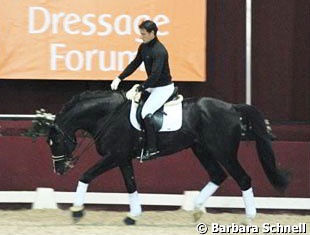
Day two, clinic one: the heart of the matter. Not a man of many words, even though he can converse in an astonishing number of languages, Jean Bemelmans had brought along two riders from his new and young Spanish team to show, not tell, how he trains them.
Jordi Domingo rode the 10-year-old Dutch warmblood Prestige, Juan Manuel Munoz Diaz presented his 9-year-old Spanish stallion Fuego. Since the subject of Hyperflexion-Rollkur had raised its ugly head several times during the previous day, Bemelmans once more made it clear that the stretching exercises he recommends to support the horse's back are ridden with a long, deep and round neck and are not to be confused with the short, round and tight neck that constitutes Hyperflexion. “I may use Hyperflexion myself now and then, but never for more than a few moments”, said Bemelmans, who believes in flexibility and variation.
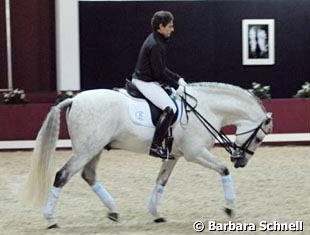 Enter Fuego, who had been walking in the arena to grease his joints during Bemelmans' introduction and started trotting with somewhat slow, not very engaged movements now, initially giving no indication what he's capable of. Bemelsmans instructed the rider to lengthen the reins and let the horse stretch towards the bit. Now, you can talk about Rollkur until your ears bleed, but after this demonstration of what happens if you ride a horse this way, the way that is called the “classical” or sometimes (derogatively?) the “German” way, no more discussion should be necessary. The horse became more engaged
Enter Fuego, who had been walking in the arena to grease his joints during Bemelmans' introduction and started trotting with somewhat slow, not very engaged movements now, initially giving no indication what he's capable of. Bemelsmans instructed the rider to lengthen the reins and let the horse stretch towards the bit. Now, you can talk about Rollkur until your ears bleed, but after this demonstration of what happens if you ride a horse this way, the way that is called the “classical” or sometimes (derogatively?) the “German” way, no more discussion should be necessary. The horse became more engaged
immediately, and you had to be blind not to see how his hind legs started moving further under the body and his whole back started swinging.
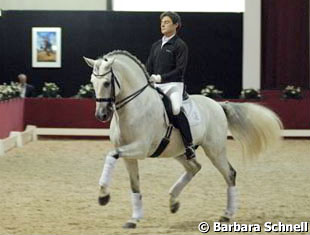 “You wouldn't believe the discussions we had when I first started training the Spanish equipe some ten years ago”, Bemelmans said. “This was totally unknown to them, and when I tried to indroduce it, they protested, 'but we need expression!'. Expression comes later, though.” And, boy, did it come. When Fuego was completely loose, Bemelmans asked the rider to shorten the reins and show first some suspended trot, which was later shortened to passage and ultimately to a beautiful piaffe. This he intercut with more stretching phases, stressing that after every collection exercise must follow a forward phase and more stretching.
“You wouldn't believe the discussions we had when I first started training the Spanish equipe some ten years ago”, Bemelmans said. “This was totally unknown to them, and when I tried to indroduce it, they protested, 'but we need expression!'. Expression comes later, though.” And, boy, did it come. When Fuego was completely loose, Bemelmans asked the rider to shorten the reins and show first some suspended trot, which was later shortened to passage and ultimately to a beautiful piaffe. This he intercut with more stretching phases, stressing that after every collection exercise must follow a forward phase and more stretching.
Likewise, with Prestige, a very spooky horse, he demonstrated how this “flexible training” (in German, Bemelmans used the word “Intervall Training”, which is even clearer) helped the horse to concentrate on the rider, how it helped the rider to get the desired control over the body of his horse which he would never achieve with pressure.
“Riding”, said Bemelmans, “is a game with an animal that likes to play. But you have to be the boss of that game.” Recalling the success story of his long-time student Beatriz Ferrer-Salat, who only got Beauvalais when he was twelve, Bemelmans admonished the crowd that “we need time. A horse's good years are from twelve to eighteen. If we destroy it before that, we are stupid.”
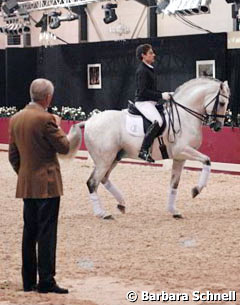 As this clinic (together with Kyra's) was the most convincing and inspiring one of this year's Forum, the panel discussion following was the most lively and interesting one. Laurens van Lieren, one of the few riders who attended the forum (others included Wayne Channon, Beatriz Ferrer-Salat and Fie-Christine Skarsoe, and the Germans once again were missing) posted a question that proved with embarrassing clarity that even top athletes often don't know what they are doing. “Is it really necessary to open the horse's frame during the extended trot?”, he asked, explaining that he finds it beautiful when the horse's
As this clinic (together with Kyra's) was the most convincing and inspiring one of this year's Forum, the panel discussion following was the most lively and interesting one. Laurens van Lieren, one of the few riders who attended the forum (others included Wayne Channon, Beatriz Ferrer-Salat and Fie-Christine Skarsoe, and the Germans once again were missing) posted a question that proved with embarrassing clarity that even top athletes often don't know what they are doing. “Is it really necessary to open the horse's frame during the extended trot?”, he asked, explaining that he finds it beautiful when the horse's
neck stays up and the extension comes only from the front legs.
Maybe there would have been more outrage if more riders had been there, but in lieu of that, Jan Bemelmans' reply was clear enough: “The neck is a horse's balance pole. When the frame opens, you see that the hind legs come forward. Coming from 'down', the horse needs to stretch. Collection is activity, but in intervals, you have to let him relax and go forward. Of course with a lengthened neck comes the swinging back, and often riders don't want to open the frame because they cannot sit it,.” This concept of intervals is, of course, how the whole Grand Prix test is designed – and why it cannot be shortened further, Mr. Kemperman.
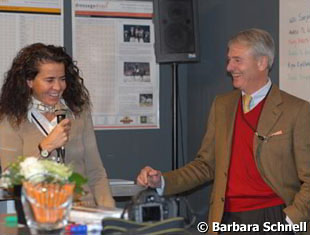 After that, Olympic judge Bernard Maurel, ignoring what Bemelmans had just said, single-handedly discarded the concept of “Rahmenerweiterung” (lenghtening of the frame) during an extension and said that “a little bit is enough”. Where is the FEI handbook when you need it???
After that, Olympic judge Bernard Maurel, ignoring what Bemelmans had just said, single-handedly discarded the concept of “Rahmenerweiterung” (lenghtening of the frame) during an extension and said that “a little bit is enough”. Where is the FEI handbook when you need it???
International judge Katrina Wüst commented that there are two ways of approaching a horse -- the “old fashioned” (as in heedless) way, and the “classical” way that was demonstrated here. “It is the responsibility of the Trainers' Club to spread the good way”, she demanded. The last word was Kyra's: “It is part of the psychology of good training that we build on the angels in our horse, not on the devils. We do what we believe in and try to get as many followers as we can.”
Back to the 2007 GDF Index